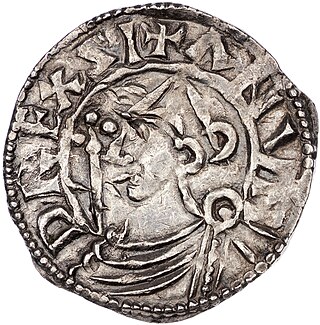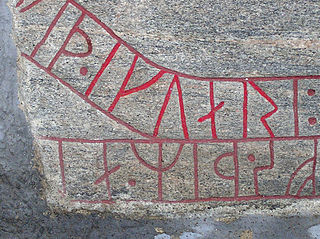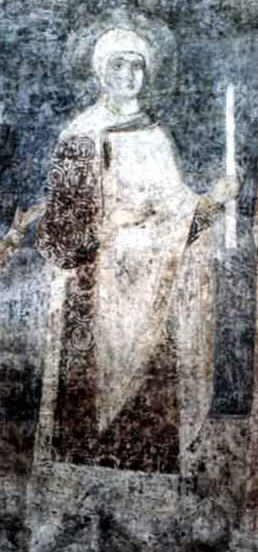Estrid of the Obotrites was Queen of Sweden in the Viking age, a West Slavic princess married to the King of Sweden, Olof Skötkonung c. 1000–1022. She was the mother of King Anund Jacob of Sweden and the Kievan Rus' saint and grand princess Ingegerd Olofsdotter.

Magnus Olafsson, better known as Magnus the Good, was King of Norway from 1035 and King of Denmark from 1042 until his death in 1047.

Olof Skötkonung, sometimes stylized as Olaf the Swede, was King of Sweden, son of Eric the Victorious and, according to Icelandic sources, Sigrid the Haughty. He succeeded his father in c. 995. He stands at the threshold of recorded history, since he is the first Swedish ruler about whom there is substantial knowledge. He is regarded as the first king known to have ruled both the Swedes and the Geats, and the first king in Sweden to have minted coins. In Sweden, the reign of Olof Skötkonung is considered to mark the transition from the Viking Age to the Middle Ages. He was the first Christian king in central Sweden. Norse beliefs persisted in parts of Sweden until the 12–13th century, with some keeping the tradition into modern times.

Anund Jacob or James was King of Sweden from 1022 until around 1050. He is believed to have been born on 25 July, in either 1008 or 1010 as Jakob, the son of King Olof Skötkonung and Queen Estrid. Being the second Christian king of the Swedish realm, his long and partly turbulent reign saw the increasing dissemination of Christianity as well as repeated attempts to influence the balance of power in Scandinavia. Throughout his reign, he tried to subvert the rising Danish hegemony in Scandinavia by supporting the Norwegian monarchy. He also supported the reign of his brother-in-law Yaroslav the Wise in Kievan Rus. He is referred to in positive terms in German and Norse historical sources. His reign was one of the longest in Sweden during the Viking Age and Middle Ages.
Emund the Old was King of Sweden from c. 1050 to c. 1060. His short reign was characterised by disputes with the Archbishopric of Bremen over church policies, and a historically debated delimitation of the Swedish-Danish border.

Ragnvald Ulfsson the Old was a jarl of Västergötland or Östergötland and was married to a sister of King Olav Tryggvason.

Ingvar the Far-Travelled was a Swedish Viking who led an expedition that fought in the Kingdom of Georgia.

Sigvatr Þórðarson or Sighvatr Þórðarson or Sigvat the Skald (995–1045) was an Icelandic skald. He was a court poet to King Olaf II of Norway, as well as Canute the Great, Magnus the Good and Anund Jacob, by whose reigns his floruit can be dated to the earlier eleventh century. Sigvatr was the best known of the court skalds of King Olaf and also served as his marshal (stallare), even baptizing his son Magnus.
Austrfararvísur is a skaldic poem composed by the Icelandic skald Sigvatr Þórðarson c. 1019. It is written in the meter dróttkvætt.
Bjørn Stallare was an 11th-century Norwegian diplomat and civil servant during the reign of King Olaf II of Norway.
Euphemia of Rügen was Queen of Norway as the spouse of Håkon V of Norway. She is famous in history as a literary figure, and known for commissioning translations of romances.

Malmfred of Kiev was a Norwegian and Danish queen consort, wife first to King Sigurd I of Norway and second to king Eric II of Denmark.
Ingeborg Eriksdotter was Queen of Norway and the wife of King Magnus VI. She was born a Danish princess, daughter of Eric IV of Denmark. As queen dowager, she played an important part in politics during the minority of her son King Eirik II of Norway in 1280-82.

Bridget Haraldsdotter, also Brigida was Queen of Sweden as the spouse of King Magnus Henriksen.
Ingegerd Haraldsdotter was a Norwegian princess who, by her successive marriages, became queen of Denmark and Sweden. Her husbands were Olaf I of Denmark and Philip of Sweden.

Elisiv of Kiev was a princess of Kiev and the queen consort of Harald III of Norway.
Ingerid Swendsdatter of Denmark was a Danish princess who became Queen of Norway as the spouse of King Olaf III of Norway.
Wulfhild of Norway was a Norwegian princess, and a duchess of Saxony by marriage to Ordulf, Duke of Saxony.
Tora Torbergsdatter was a Norwegian royal consort. She was the mother of two kings of Norway. It is possible, but unconfirmed, that she was also queen of Denmark or Sweden.
Ingegerd Olofsdotter, also known as Irene or Anna, was a Swedish princess and the grand princess of Kiev from 1019 to 1050 as the wife of Yaroslav the Wise. She was the daughter of the Swedish king Olof Skötkonung by his wife Estrid of the Obotrites. She is venerated as a saint in the Eastern Orthodox Church.









